People
‘I Was Angry and I Sewed’: Sterling Ruby on How Growing Up in Small-Town America Drove Him to Make Art—and Break the Rules
The artist has two major presentations on view in Europe.
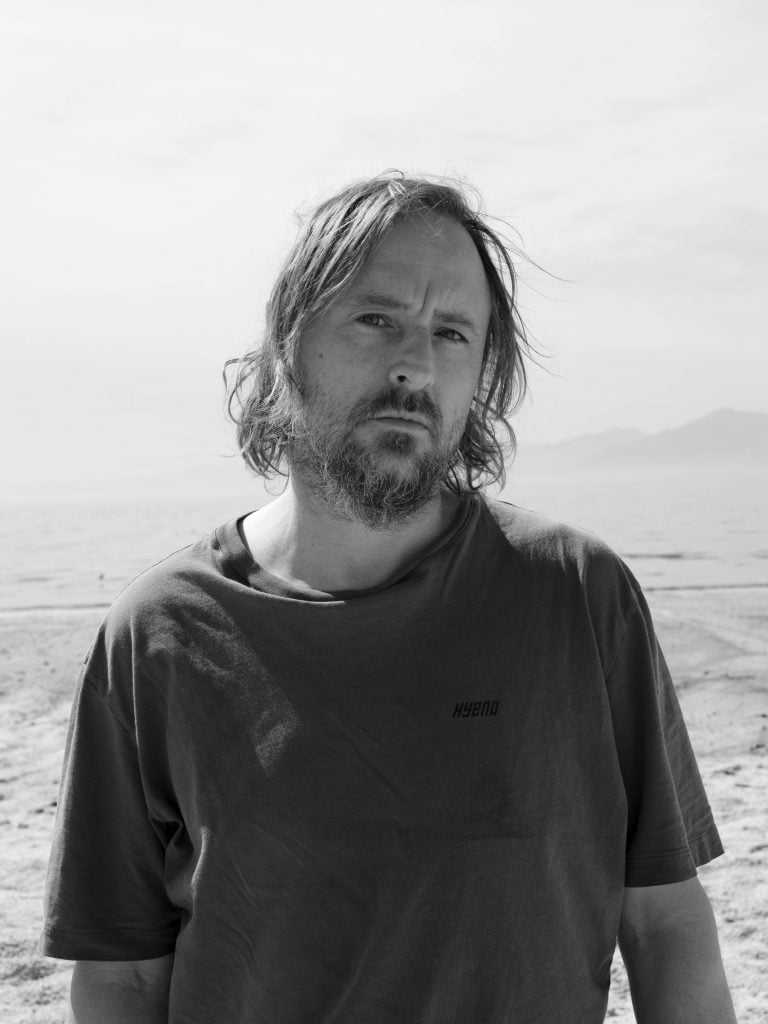
The artist has two major presentations on view in Europe.

Hili Perlson

Sterling Ruby was pondering his installation at Sprüth Magers gallery as he turned to me in his trademark lean-in-to-listen voice, explaining that some pieces have been in the making for over a decade. “Sometimes you revisit things because it’s the perfect space,” he said. Indeed, his monumental tapestries and voluptuously glazed ceramics have a deserving host here across the Berlin gallery’s two-storey venue.
His exhibition “In Warm Shroud. Kissing the Bloom Crux. A Frost Window,” (on view from April 29 to June 30) which features a €50 silk-screen print edition to raise funds for Ukrainian refugees, marks a homecoming of sorts for the L.A.-based art star, back to his stomping ground in the art world. In Europe in 2019, he had debuted his fashion collection as a special guest at Florence’s premiere fashion trade show, Pitti Uomo. The art world—typically in denial of its own deep reliance on fashion bucks—rolled its eyes. The New Yorker ran a piece addressing the anxieties on his gallerists’ and collectors’ minds, that inevitably also gnawed at Ruby: Will a clothing line devalue his art?
The answer seems clear now. Fresh off the heels of his first intervention on the façade of Nicolas Berggruen’s newly acquired Venetian palazzo, and surrounded by his haunting, atmospheric suite of acrylic and oil paintings resembling frost on window panes at Sprüth Magers, it’s clear his market—and his art-making—indeed survived the fashion label launch unscathed.
Speaking about the origins of his passion for textiles and fashion, Ruby reflects on being a teenage misfit in rural Pennsylvania, U.S., and the realizations that came decades later about the community he grew up in.
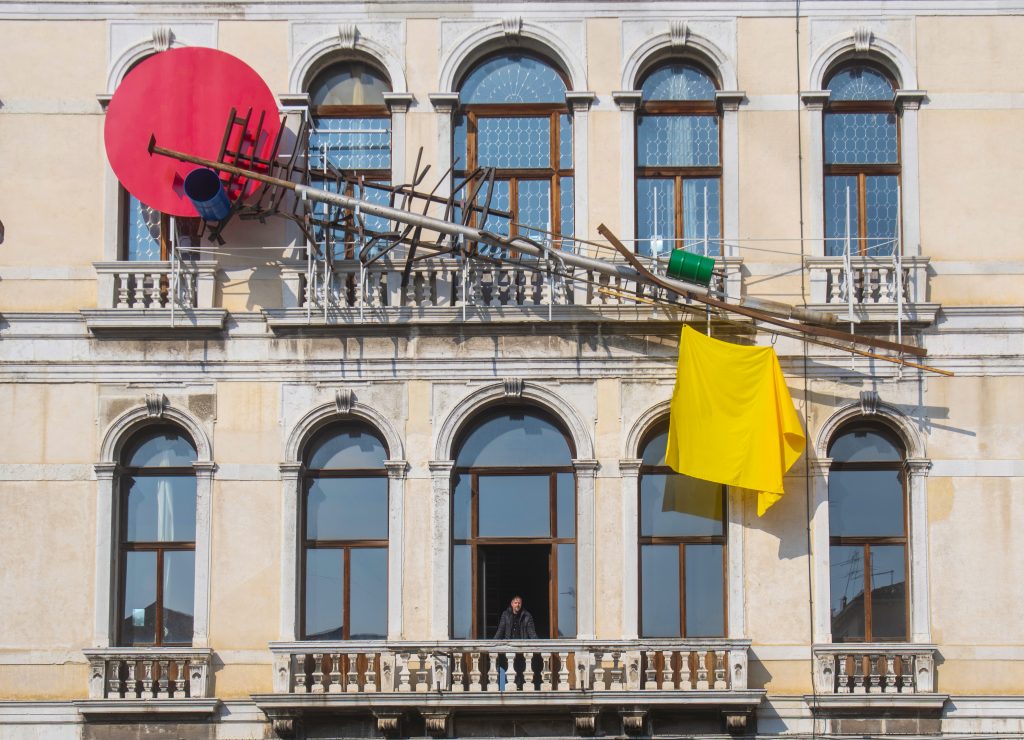
Sterling Ruby’s HEX on the façade of Palazzo Diedo, the home of Berggruen Arts & Culture, and the first phase of “A Project in Four Acts,” during the opening week of the 59th Biennale Arte on April 20, 2022 in Venice, Italy. (Photo by Simone Padovani/Awakening/Getty Images for Berggruen Arts & Culture)
Your practice is multi-pronged and spans a variety of media, but you are very much associated with textiles, be it in your art practice, collaborations with fashion designers, or your own capsule collection—which we will get to later. Where does your fascination with textiles come from?
I’ve been making textile works for over 15 years, be it textile sculptures, my own version of quilting, flags, or clothing. Where I grew up, among Amish and Mennonite communities in Pennsylvania, the area was predominantly drab farms and monochromatic scenes. And then there would be these extremely bright, colorful, imperfect quilts.
When I started to really think about becoming an artist, I was initially ashamed of where I was raised because it didn’t seem like quilting was welcome in the context of contemporary art. That has changed considerably as of late. I didn’t know Ellsworth Kelly then, but I knew Amish, Mennonite quilts; I knew Baltimore pictorial quilts. Over time, I started to realize that this is part of who I am; it is part of my history, part of understanding craft and the aesthetic that I was exposed to early. I should be doing this.
I wanted to collapse things together for these pieces [on view at Sprüth Magers]. I thought about quilts historically among the communities where I lived, but also as a tool of resistance, associating them with protests and activist banners I witnessed during my time in cities like Baltimore and Washington D.C. in the midst of the Reagan era. And now, after 20 years in California, I contemplated scale in relation to things like tie-dye backdrops at Grateful Dead concerts. I also considered textiles logistically [superior, as] they can be rolled up and taken through a small door and then hung on a very grand scale in a way that a stretched painting cannot.
Where do you source the textiles? There’s a pleated denim collage in the show that’s made of very high-end materials for example.
We process and dye textiles in the studio, but I also develop fabric at mills in Italy and Japan, whether it be a 13-ounce raw denim or an open weave plaid. Then there are found bits. A number of pieces in the quilts are very old, moth-ridden wool blankets from the Civil War era. There’s a lot that comes from where I grew up—I buy from auction houses back in this region. Blanket after blanket sits in my studio, distressed textile pieces from the 1800s to early 1900s. And there’s no provenance—you don’t know who made it. I’m mixing timelines and these significant regional qualities.
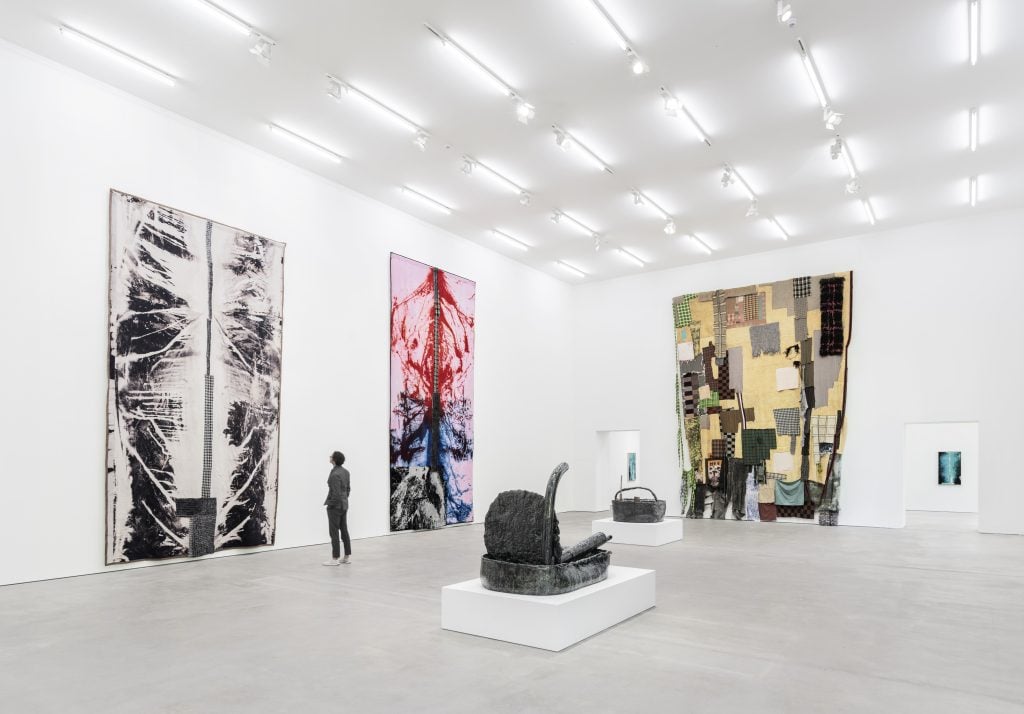
Installation view of the exhibition: Sterling Ruby “In Warm Shroud. Kissing the Bloom Crux. A Frost Window.” Sprüth Magers, Berlin (April 29 – June 30, 2022). Photo: Ingo Kniest
Is there also a gendered element that you’re alluding to? The antique quilts were most likely sewn by women and girls.
The gender component is very prominent. It’s taken me a long time to accept where I grew up and the beliefs that so many people there held.
My mother was Dutch, my father was from Baltimore, and when we initially came to the U.S., we lived in Baltimore [Ruby was born in Germany while his father was assigned to a military base there]. But in all actuality, my parents were hippies and deep down wanted to be farmers. When I was eight we moved to New Freedom, Pennsylvania. I went to an agriculture school all through high school. If you were a boy, you did woodworking, welding, and machine studies. And if you were a girl, you had to take home economics, sewing, and classes about having children. I wasn’t identifying with any of that in terms of sexuality, but intuitively I felt it wasn’t for me. I hated it, I despised where I went to school. I didn’t want to be there. I knew there were other things that I could do that were creatively unrestrained.
I had my mom petition to the school every term so that I could enroll in home economics, sewing, and calligraphy, which I always wanted to take and which the school preferred me not to. I mean, the calligraphy course was about designing your wedding invitations. Turns out, I was very good at it!
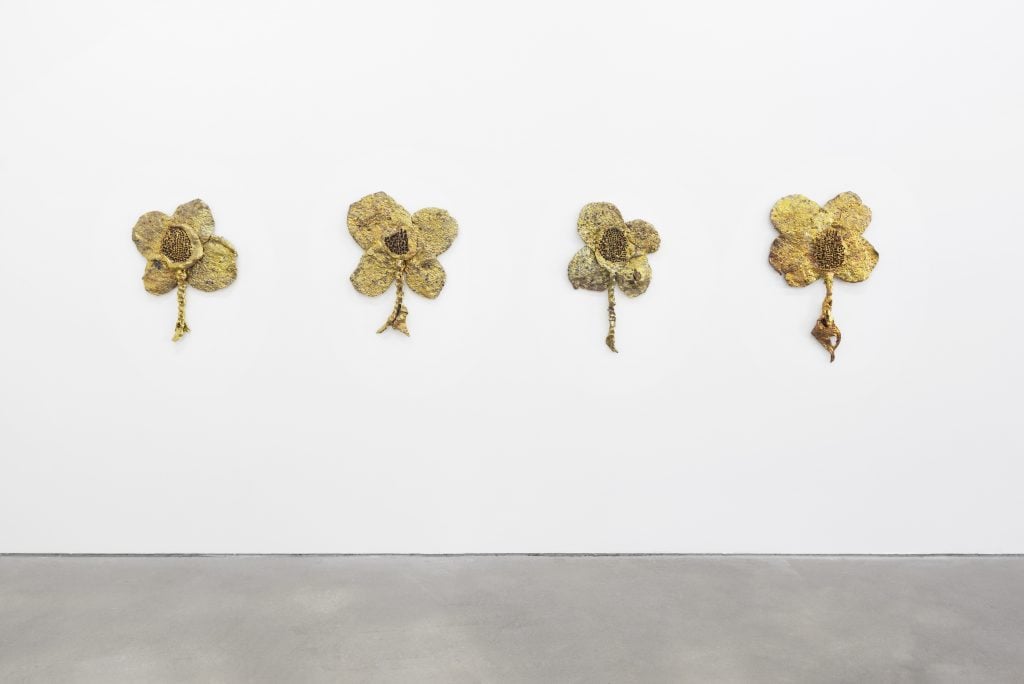
Installation view of the exhibition: Sterling Ruby “In Warm Shroud. Kissing the Bloom Crux. A Frost Window.” Sprüth Magers, Berlin (April 29 – June 30, 2022). Photo: Ingo Kniest
I read that your mom also bought you your first Singer sewing machine.
My mother and my grandmother were both seamstresses, and I loved sewing. She bought me a machine when I was 13. I would go to Washington, D.C. and Baltimore to see punk bands all the time. It was a very fertile era, there were a lot of politics and activism within that genre of music. I would sew my own clothes with texts and drawings on them and bring that back to this tiny little agriculture school that I was getting suspended from all of the time, getting into fights because I looked different.
It wasn’t until I finally attended The Art Institute of Chicago that I started to take classes on feminist theories and gender politics. And that’s when I realized why I got into so many fights. You know, I have four children and their gender and sexuality seems more fluid to me. I can’t imagine them having to live in a place like where I grew up. I love the fact that my children have different choices. It just seems so freeing to have these choices and the time to make them. I guess that’s probably how I felt at the time, too, and I didn’t process it that way. I was angry, really angry. But I was angry and I sewed.
One of the quilted works has an image printed on it, with the word “hex.” What is that a reference to?
It’s the cover of a book by Arthur Lewis, about a man who had been accused of magically putting a hex on three boys and damaging local crops. The three boys murdered him in 1928 because the community suspected him of witchcraft. Many consider it the very last witch trial in America. It takes place in the small town where I grew up; we all read it at school because it was local history. It’s this kind of suspicion that you might still feel today, when different opinions within communities lead to judgement, accusations, discord, or even violence.
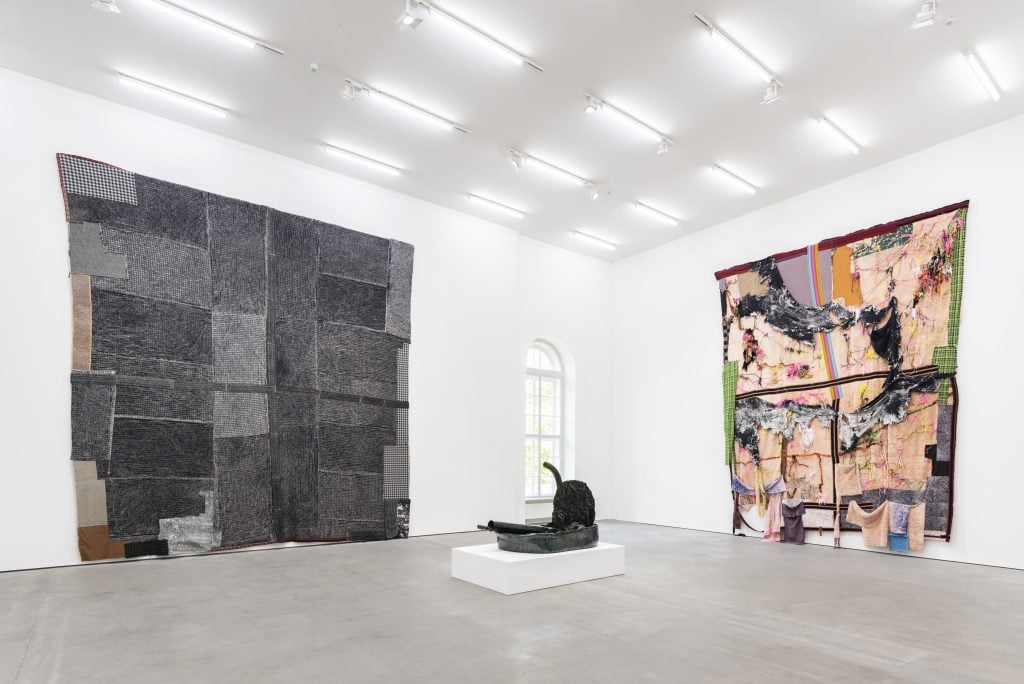
Installation view of the exhibition: Sterling Ruby “In Warm Shroud. Kissing the Bloom Crux. A Frost Window.” Sprüth Magers, Berlin (April 29 – June 30, 2022). Photo: Ingo Kniest
“Hex” is also the name of the work you’ve just unveiled in Venice, on the façade of the 17the century Palazzo Diedo on the Grand Canal, acquired by the Nicolas Berggruen Charitable Trust. As its first artist-in-residence, you’ll be spending a lot of time in Venice in the next couple of years. What does that entail exactly?
I’m not totally sure! Nicolas and I planned that I would do three projects that are based on the exterior of the building while the interior is being renovated. The first one was installed last week [coinciding with the Venice Biennale’s opening] and will remain up for a number of months. We’ll do another two and then, in spring 2024, we’ll do a full exhibition throughout the entire interior.
Last week, we wound up visiting a number of glass factories and looking into production possibilities. Part of the discussion that Nicholas and I have had is about this idea of Venice as a place of artistic production over the centuries. I want to say that I have very definitive plans, but…
Well, if there’s anything we’ve learned from the COVID-19 pandemic is that nothing is definitive, least of all plans.
You’re right. Nicholas and I were in the same city, so throughout the pandemic he was one of the only people I saw. We shut down the studio—we were all working remotely—I would go in by myself. Nicholas and I started doing frequent studio visits. I didn’t completely know what his plans were in Venice, but at one point he just said, “Hey, would you like to do this?”
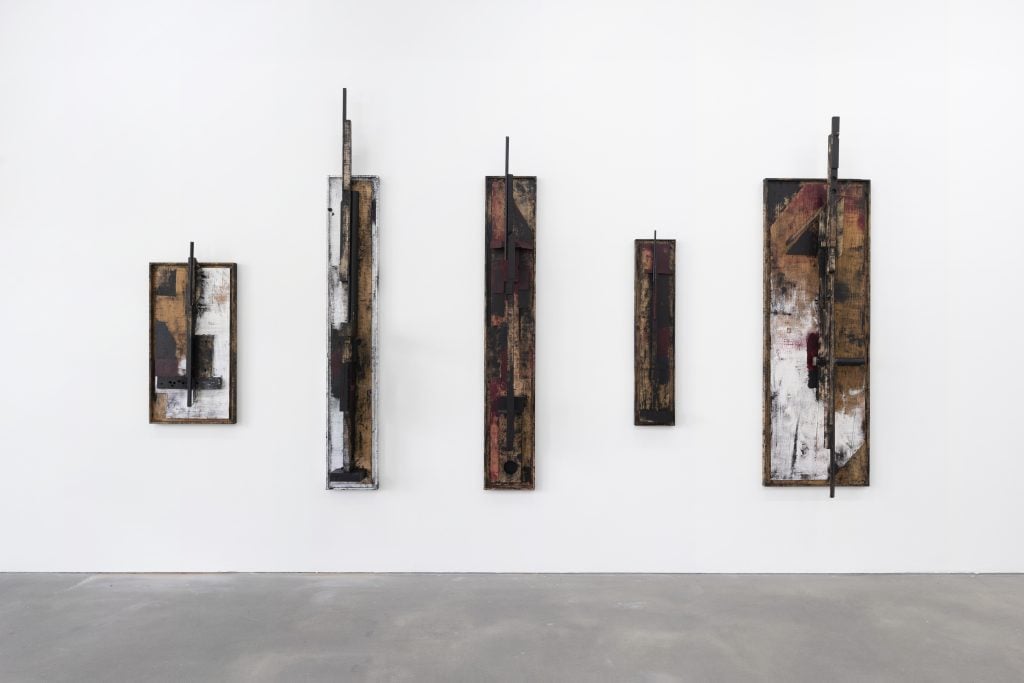
Installation view of the exhibition: Sterling Ruby “In Warm Shroud. Kissing the Bloom Crux. A Frost Window.” Sprüth Magers, Berlin (April 29 – June 30, 2022). Photo: Ingo Kniest
There are wooden sculptures in the show at Sprüth Magers that reminded me of Louise Nevelson’s pieces; I assume these also relate to your personal history, and all those woodwork classes.
When my mom passed away years ago, my father sold the land but I wanted to keep her barn. So we took it down and shipped it to California. It’s all chestnut and walnut, which is very difficult to find nowadays in the U.S. Maybe I will rebuild this Amish barn one day, in downtown L.A. For now, there are parts of her barn in these REIF works, compiled alongside offcuts and discarded scraps from my wood shop. It’s again a kind of recycling and regenerating of materials into something new, like the quilts.
We have a tiny Louise Nevelson that we walk by every day in the house. It’s very simple, made of a couple of pieces of scrap. I’ve always loved that type of work, just geometric shapes nudged up against one another in order to create volume and movement.
It almost sounds like you’re talking about garment-making. Is there a difference for you between your work in fashion and in art? You officially launched your line S.R. STUDIO. LA. CA. at Pitti Uomo (the menswear fashion equivalent of a major art fair) in Florence in 2019.
No, not really. I think it’s pretty similar. When I first started I would take some fabric that was meant to be a sculpture and turn it into a pair of pants. That was somehow this ritual, you know, like cannibalizing your own work. And this ritual started to grow. We didn’t think of it as a label, but we were already making labels to put on it, as a conceptual project.
Then I met people in the fashion industry, Raf Simons, Rick Owens, Matthieu Blazy, Pieter Mulier, and Michèle Lamy. I thought they were brilliant — as smart and ambitious as any artists in the way that they thought about fashion. I started working with Raf on Dior and later with Calvin Klein. I saw the industry more closely, which is very different from the art world.
When we got invited by Pitti Uomo, we decided to launch publicly. I was curious to see—maybe there could be a notion of industrialization that was similar to what I was thinking about in the studio, like in the Bauhaus. We still make almost everything in the studio through small runs. I don’t think we’ve ever made any more than 50 of anything. Scaling up could happen, but it would be a different project then. I wish that our production could be a little less costly, but unfortunately we have to spend a lot because we don’t do quantity. That’s my biggest criticism of the fashion industry, that it makes too much, because it’s cheaper to do so, and I don’t believe in that.
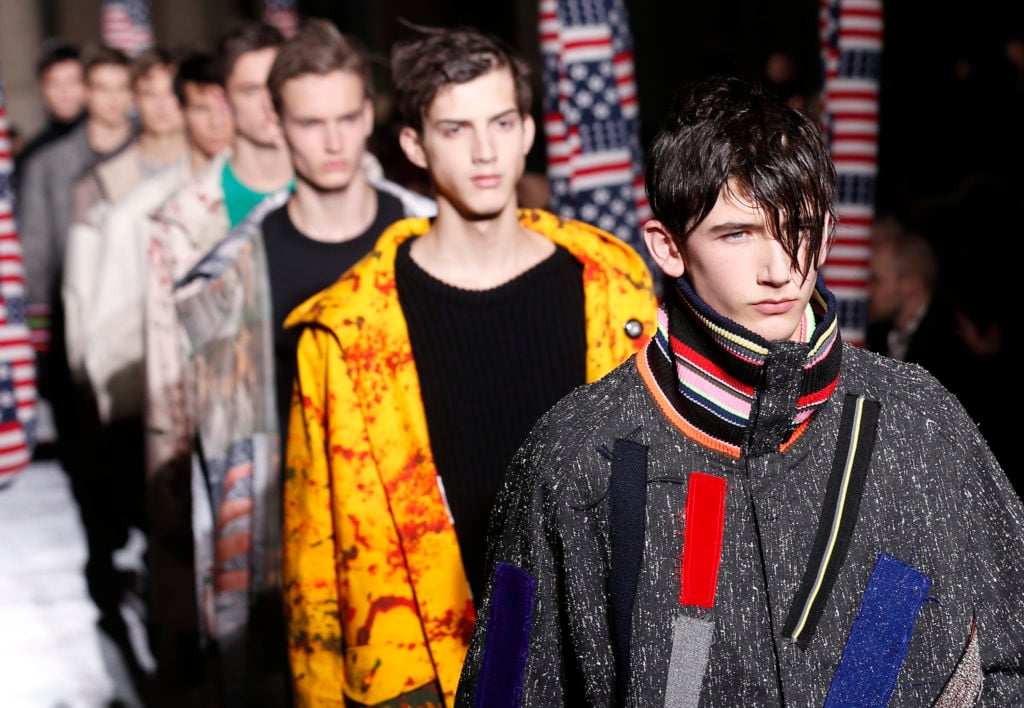
Models present creations by Raf Simons/Sterling Ruby during the Fall/Winter 2014–2015 men’s fashion show in Paris on January, 15, 2014. Photo by Francois Guillot/AFP/Getty Images.
The fashion industry courts the art world with major sponsorships, but they’re still considered strange bedfellows.
When I designed Raf’s first store in Tokyo in 2008, and then when we did our collection together, it wasn’t something that the art world was very accepting of. And I’ve just watched it completely switch. I get it from a from a luxury goods scenario—if you think that everything is a luxury good, then that makes a lot of sense. But these companies generate a lot of money and they’re putting that into supporting whatever art is beneficial at the moment. Maybe both art and fashion should consider longevity over trends.
Sterling Ruby’s exhibition “In Warm Shroud. Kissing the Bloom Crux. A Frost Window” is on view at Sprüth Magers, Berlin from April 29 to June 30, 2022. “Hex” is on view at the Berggruen Arts & Culture in Venice concurrently with the 59th Venice Biennale.